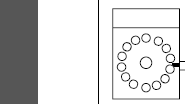This set of Biomedical Instrumentation Questions and Answers for Aptitude test focuses on “Skin Reflectance Oximeters”.
1. Which module consists of a pair of Perspex plates?
a) The dialyzer module
b) The recorder module
c) The sampling module
d) Heating bath module
View Answer
Explanation: In analytical chemistry, it is often necessary to remove protein cells to obtain an interference-free analysis. This is accomplished by dialysis in the auto-analyzer. The dialyzer module consists of a pair of perspex plates, the mating surfaces of which are mirror grooved in a continuous channel, which goes in towards the centre, on itself and returns to the outside.
2. The part of the automated system that shown in the figure is ____________

a) Dialyzer
b) Pump
c) Recorder
d) Sampler
View Answer
Explanation: The automated system consists of a group of modular instruments interconnected together by a manifold system and electrical systems. The sample to be analyzed is introduced into a stream of diluting liquid flowing in the narrow bore of a flexible plastic tube. The stages of the analytical reaction are completed by the successive combination of other flowing streams of liquids with the sample stream, by means of suitably shaped glass functions.
3. In the sampling unit, when it is in its earlier form consisted of a circular turntable carrying around its rim 40 disposable __________ of 2 ml capacity.
a) Polyvinyl cups
b) Polythene cups
c) Polyester cups
d) Polystyrene cups
View Answer
Explanation: The unit in its earlier form consisted of a circular turntable carrying around its rim 40 disposable polystyrene cups of 2 ml capacity. The sample plate carrying these cups rotates at a predetermined speed. The movement of the turntable is synchronized with the movements of a sampling crook.
4. What is the ratio of the sampling time to wash time?
a) 1:2
b) 3:1
c) 2:1
d) 1:3
View Answer
Explanation: Between each sampling, the crook enters a receptacle of water or other suitable wash fluid, to reduce cross-contamination of one sample with another. The ratio of sampling time to wash time is normally 2:1.
5. Which of the following is not the part of the manifold?
a) Transmission tubing
b) Pump tubes
c) Platter
d) Plastic tubes
View Answer
Explanation: A manifold mainly consists of a platter, pump tubes, coils, transmission tubing, fittings and connections. A separate manifold is required for each determination and the change can be effected within a few minutes. The pump tubing and the connected coils are placed on a manifold platter, which keeps them in proper order for each test.
6. Which of the following is not the type of tubing?
a) Acidflex tubing
b) Glass tubing
c) Polypropylene tubing
d) Tygon
View Answer
Explanation: Several other tubes are required to introduce reagents and to transport the specimen from one module to another. There are five types of such tubings. They are of varying sizes and are to be selected according to the requirements. These are standard transmission tubing (Tygon), solvaflex tubing, acidflex tubing, polyethylene tubing and glass tubing.
7. There are two types of coils employed in the system, which are ____
a) Tygon coils and mixing coils
b) Mixing coils and tubing coils
c) Delay coils and tygon coils
d) Mixing coils and delay coils
View Answer
Explanation: Two types of coils are employed in the system—mixing coils and delay coils. Coils are glass spirals of critical dimensions, in which the mixing liquids are inverted several times, so that complete mixing can result. Mixing coils are used to mix the sample and/or reagents. Delay coils are employed when a specimen must be delayed for the completion of a chemical reaction before reaching the colorimeter.
8. In phasing, if the cholesterol stream arrives at Y time, albumin must arrive at ______
a) Y + 5 s
b) Y + 10 s
c) Y + 15 s
d) Y + 20 s
View Answer
Explanation: With 12 tests to be recorded on each sample and a sampling rate of 60 samples per hour, it follows that 5 s are allowed to record each steady state plateau. The reaction streams in the 12 channels and up to four blank channels must, therefore, be phased to arrive at the colorimeter in waves 5 s apart. For example, if the cholesterol stream arrives at X time, calcium must arrive at X + 5 s, total protein at X + 10 s, albumin at X + 15 s, etc.
9. Which coils are used to permit the channels to enter the calorimeter in the proper sequence?
a) Mixing coils
b) Delay coils
c) Solvaflex coils
d) Phasing coils
View Answer
Explanation: In order to ensure a proper sequencing for the presentation of results, a number of devices have been provided to make this adjustment an extremely simple operation. Phasing coils are used to permit the channels to enter the colorimeter in the proper sequence.
Sanfoundry Global Education & Learning Series – Biomedical Instrumentation.
To practice all areas of Biomedical Instrumentation for Aptitude test, here is complete set of 1000+ Multiple Choice Questions and Answers.
If you find a mistake in question / option / answer, kindly take a screenshot and email to [email protected]
- Practice Biotechnology MCQs
- Check Biotechnology Books
- Apply for Biotechnology Internship
- Check Biomedical Instrumentation Books
